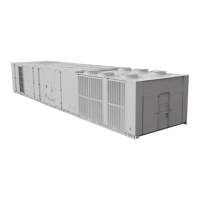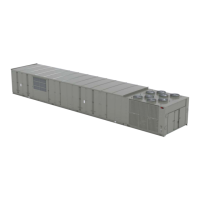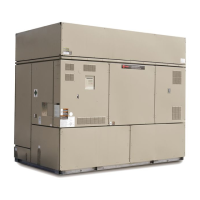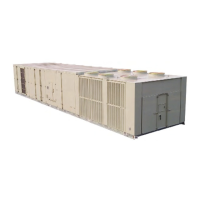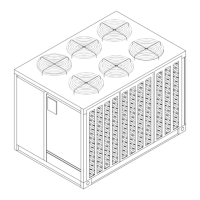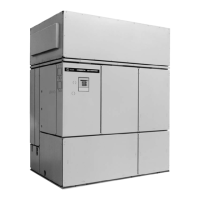46
RT-SVX072A-EN
NNOOTTIICCEE
OOvveerr TTiigghhtteenniinngg!!
FFaaiilluurree ttoo ffoollllooww iinnssttrruuccttiioonnss bbeellooww ccoouulldd
rreessuulltt iinn ddaammaaggee ttoo tthhee ccooiill hheeaaddeerr..
DDoo nnoott uussee tteefflloonn--bbaasseedd pprroodduuccttss ffoorr aannyy ffiieelldd
ccoonnnneeccttiioonnss bbeeccaauussee tthheeiirr hhiigghh lluubbrriicciittyy ccoouulldd
aallllooww ccoonnnneeccttiioonnss ttoo bbee oovveerr ttiigghhtteenneedd..
☐ Use pipe sealer on all thread connections.
NNOOTTIICCEE
LLeeaakkaaggee!!
FFaaiilluurree ttoo ffoollllooww iinnssttrruuccttiioonnss bbeellooww ccoouulldd
rreessuulltt iinn eeqquuiippmmeenntt ddaammaaggee..
PPrrooppeerrllyy sseeaall aallll ppeenneettrraattiioonnss iinn uunniitt ccaassiinngg
ffrroomm iinnnneerr ttoo oouutteerr ppaanneell iinn oorrddeerr ttoo pprreevveenntt
uunnccoonnddiittiioonneedd aaiirr ffrroomm eenntteerriinngg tthhee mmoodduullee,, aass
wweellll aass pprreevveenntt wwaatteerr ffrroomm iinnffiillttrraattiinngg tthhee
iinnssuullaattiioonn..
☐ After completing the piping connections, seal
around pipe from inner panel to outer panel.
Hot Water Heat Units (SLH_)
Hot water heating coils are factory installed inside the
heater section of the unit. Once the unit is set into
place, the hot water piping and the factory provided 3–
way modulating valve must be installed. The valve can
be installed inside the heat section or near the unit. If
the valve is installed in a remote location, use field
supplied wiring to extend the control wires from the
heater section to the valve. Two access holes are
provided in the unit base as illustrated in .
Use the following guidelines to enhance both the
installation and operation of the “wet heat” system.
Figure 26, p. 48 illustrates the recommended piping
configuration for the hot water coil. Table 19, p. 47 lists
the coil connection sizes.
NNoottee:: The valve actuators are not waterproof. Failure to
protect the valve from moisture may result in the
loss of heating control.
1. Support all field-installed piping independently
from the heating coil.
2. Use swing joints or flexible connectors adjacent to
the heating coil. (These devices will absorb the
strains of expansion and contraction).
3. All return lines and fittings must be equal to the
diameter of the “outlet” connection on the hot
water coil.
4. Install a “Gate” type valve in the supply branch line
as close as possible to the hot water main and
upstream of any other device or takeoff.
5. Install a “Gate” type valve in the return branch line
as close as possible to the return main and down
stream of any other device.
6. Install a strainer in the hot water supply branch as
shown in Figure 26, p. 48.
7. Install the 3-way valve in an upright position, piped
for valve seating against the flow. Ensure that the
valve location lends itself to serviceability.
8. The Type “W” hot water coil used in SLH_ units is
self-venting only when the tube water velocity
exceeds 1.5 feet per second (fps). If the tube
velocity is less than 1.5 feet per second, either:
a. install an automatic air vent at the top of the
return header, using the tapped pipe connection
or,
b. vent the coil from the top of the return header
down to the return piping. At the vent
connection, size the return piping to provide
sufficient water velocity.
9. Install a “Globe” type valve in the Bypass line as
shown in Figure 26, p. 48.
Steam Heat Units
Steam heating coils are factory installed inside the
heater section of the unit. The coils are pitched within
the units to provide the proper condensate flow from
the coil. To maintain the designed degree of pitch for
the coil, the unit must be level.
Once the unit is set into place, the steam piping and the
factory provided 2–way modulating valve must be
installed. The valve can be installed inside the heater
section or near the unit. If the valve is installed in a
remote location, use field supplied wiring to extend the
control wires from the heater section to the valve. Two
access holes are provided in the unit base as illustrated
in .
Use the following guidelines to enhance both the
installation and operation of the “wet heat” system.
Figure 28, p. 49 and Figure 29, p. 49 illustrates the
recommended piping configurations for the steam coil.
lists the coil connection sizes.
NNoottee:: The valve actuators are not waterproof. Failure to
protect the valve from moisture may result in the
loss of heating control.
1. Support all field-installed piping independently
from the heating coil.
2. Use swing joints or flexible connectors adjacent to
the heating coil. (These devices will absorb the
strains of expansion and contraction.)
3. Install the 2-way valve in an upright position.
Ensure that the valve's location lends itself to
serviceability.
4. Pitch the supply and return steam piping downward
1" per 10' of run in the direction of flow.
5. All return lines and fittings must be equal to the
diameter of the “outlet” connection on the steam
coil(s). If the steam trap connection is smaller that
the coil “outlet” diameter, reduce the pipe size
IInnssttaallllaattiioonn
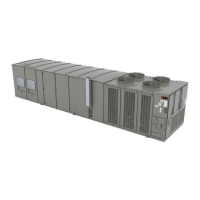
